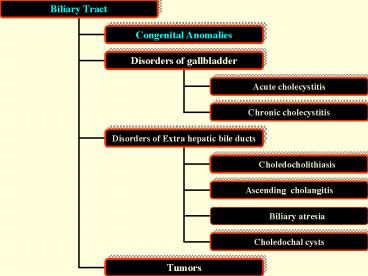Liver - PowerPoint PPT Presentation
1 / 16
Title:
Liver
Description:
Biliary tract infection (E. coli, Ascaris lumbricoides, liver fluke -Opisthorchis) ... in the adult life = Obstructive biliary complications and bile duct carcinoma ... – PowerPoint PPT presentation
Number of Views:64
Avg rating:3.0/5.0
Title: Liver
1
(No Transcript)
2
- MC congenital anomalies abnormal variants of
the gallbladder - MC folded fundus (Phrygian cap)
- Others congenitally absent, bilobed or
aberrantly located gall bladder
Most common congenital anomaly
3
- Cholelithiasis (Gall Stones)
- 10 to 20 of adults in developed countries
- Two kinds of stones
- 1. Cholesterol Stones crystalline cholesterol
monohydrate, - Risk factors
- Native American
- adult in industrialized country
- increased age (gt40 yrs, Forty)
- Females 21
- estrogenic influences (Fertile)
- Clofibrate
- Obesity (Fatty) or rapid weight loss
- Gallbladder stasis,
- in spinal cord injury
- pregnancy
- Hypercholesterolemic syndromes
4
- 1. Cholesterol Stones contd
- Four conditions -necessary for cholesterol stone
formation - supersaturated bile with cholesterol
- gallbladder hypomotility ? promotes crystal
nucleation - microprecipitates of calcium salts (inorganic or
bilirubin salts) - Mucus hypersecretion in the gallbladder
- Morphology Pale yellow and hard, ovoid, usually
single, Often radiolucent - Cholesterol stones arise exclusively in the gall
bladder - 2. Pigmented Stones bilirubin calcium salts
- Risk factors
- Asian, Rural
- Chronic hemolytic syndromes
- Biliary tract infection (E. coli, Ascaris
lumbricoides, liver fluke -Opisthorchis) - Ileal disease (resection or bypass)
- Cystic fibrosis with pancreatic insufficiency
- Mechanisms? Unconjugated bilirubin in the
biliary tree and precipitation of calcium
bilirubin salts - Morphology more often radiopaque, black color
- Clinical( both types) 70 to 80 of gallstone
patients -asymptomatic
5
- Clinical( both types)
- Symptoms
- spasmodic, colicky pain, owing to obstruction of
bile ducts by passing stones, - gallbladder obstruction per se generates right
upper abdominal pain, - Complications cholecystitis, Empyema,
perforation, fistulas, cholangitis, Obstructive
cholestasis or pancreatitis and , gallstone
ileus, Mucocele - other sites of Mucocele?
6
Cholelithiasis (Gall Stones)
7
- Acute Cholecystitis acute Inflammation of the
gallbladder - Cause MCC gallstone obstruction of the neck or
the cystic duct(90 ) - Rarely without gallstone obstruction (10)-
severely ill patients (ex. in the postoperative
state, severe trauma, severe burns, multisystem
organ failure, sepsis, prolonged
hyperalimentation or postpartum state) - Symptoms of CBD obstruction acute right upper
quadrant or Epigastric pain, mild fever,
anorexia, tachycardia, diaphoresis, nausea and
vomiting, jaundice - Patho Mechanisms bile acids (in
cholelithiasis pts.) ? chemical irritation of
gallbladder? inflammatory mediators
(lysolecithin, prostaglandins) - in the severely ill patient direct result of
ischemia - Gross enlarged, tense gallbladder , fibrin on
serosal covering - Course mild and intermittent or may be a
surgical emergency, - self-limited and mortality is less than 1, or
severely ill patient with mortality is higher, - complications
- cholangitis and sepsis
- gallbladder perforation or rupture
- enteric fistula formation
8
- Chronic Cholecystitis
- Causes MCC from repeated bouts of symptomatic
acute cholecystitis or - Morphology fibrosed, contracted gallbladder, GB
wall - thickened and gray-white - Microscopy mucosa is preserved
- Cholesterolosis cholesterol-laden macrophages in
the lamina propria - Gallstones
- Rokitansky -Aschoff sinuses Mucosal out pouching
- porcelain gallbladder rarely - dystrophic
calcification - xanthogranulomatous cholecystitis Fibrosed,
nodular histiocytic inflammation of gallbladder - Clinically steady or colicky Recurrent attacks
of Epigastric or right upper quadrant pain - Complications same as acute
9
Cholecystitis
10
(No Transcript)
11
- Choledocholithiasis Stones within the biliary
tree - in about 10 of patients with cholelithiasis
- Western nations - almost all stones are derived
from the gallbladder (cholesterol stones) - Asia- stones are usually primary and pigmented
- Symptoms arise from
- obstruction
- pancreatitis
- cholangitis
- hepatic abscess
- secondary biliary cirrhosis
- acute calculous cholecystitis
- Ascending Cholangitis Bacterial infection of
the bile ducts, - Common in the setting of Choledocholithiasis,
- Ascending bacteria (E. coli, Klebsiella and other
enterobacteria) enter the biliary tract through
the sphincter of Oddi
12
- Extrahepatic Biliary Atresia Complete
obstruction of bile flow - unknown cause
- Mechanism destruction or absence of all or part
of the extrahepatic bile ducts - Normal at birth , later progressive inflammatory
destruction - Liver changes (same as cholestasis)
- marked bile duct proliferation
- portal tract edema and fibrosis
- Cirrhosis within 3 to 6 months
- Clinical features neonatal cholestasis with
normal birth weight postnatal weight gain - Treatment liver transplantation is curative
- if untreated, death occurs within 2 years of
birth - Choledochal Cysts
- congenital dilations of the CBD in Children lt ten
yr. age - Clinically Jaundice, recurrent abdominal pain
- Complications
- Predispose to stone formation, stenosis and
stricture, pancreatitis, - in the adult life Obstructive biliary
complications and bile duct carcinoma
13
Extrahepatic Biliary Atresia
14
(No Transcript)
15
- Carcinoma of Gall Bladder (GB) FgtM, in their
60's - Gallstones coexist in patients in Western nations
- critical risk factorChronic inflammation of GB
- MC- adenocarcinomas
- unresectable when discovered
- prognosis really is BAD
- Extahepatic Bile Duct Carcinoma uncommon
malignancies of the extrahepatic biliary tree
down to the ampulla of Vater - Risk factors
- choledochal cysts Calori disease
- ulcerative colitis,
- Biliary infection with C. sinensis
- MC- adenocarcinomas,
- Klatskin's tumors
- tumors arising at the confluence of the right and
left hepatic bile ducts - notable for slow growth,
- sclerosing behavior and
- infrequency of distant metastasis
- Good Prognosis
16
Gallbladder- Carcinoma































